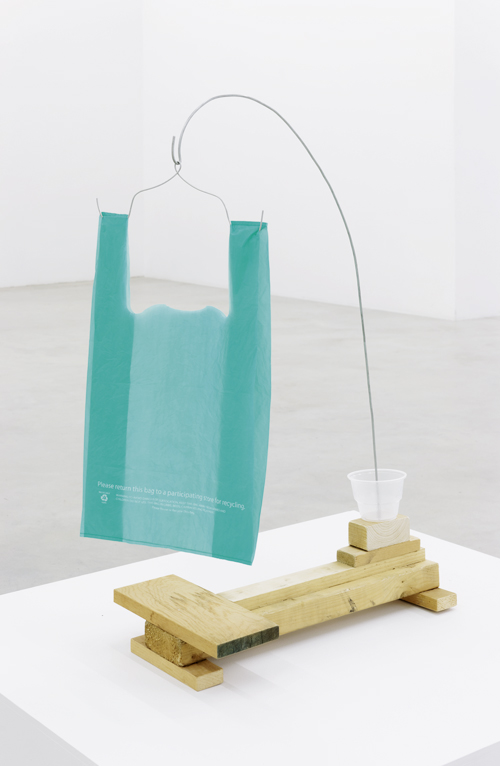B. Wurtz
Gregor Podnar, Berlin
Gregor Podnar, Berlin

Born in 1948 in Pasadena, California, B. Wurtz came of age when early Conceptual art was just getting into its swing. Although his work has nothing of that movement’s emphasis on its own objectivity, or its taxonomical fervour, it shares an interest in arbitrary logic, and in reformulating the premises of art making from scratch. While the early conceptual impulse to reinvent sculpture from the ground up, interpreted literally, might be the underlying dynamic of his art – he is always putting one thing on top of another, tentatively but fastidiously, as if newly discovering that sculpture is an accretive process – the arbitrary logic is manifested in Wurtz’s eccentric rule that all his materials should have something to do with three of life’s necessities – food, clothing or shelter. The three-necessities rule has a heroic, existentialist ring that is belied by the whimsical light-footedness of the art itself. Wurtz proceeds as though anything could happen to qualify an object at any moment in its composition.
This freedom comes with a remarkable absence of grandiloquence or swagger. It registers rather as an index of desperation and futility, a last-ditch recklessness. If anything can be done then it may seem absurd to do one thing rather than something else; as absurd as having sculpture, usually a place exempt from life’s survival necessities, be contingent upon three of its categories. This absurdity multiplies with every move. Typically, a standard plinth will be surmounted, tautologically, by a stand, constructed out of timber offcuts. This material proves to be the sculpture’s greater part, supporting an object of ineffable insubstantiality: a carrier bag (Untitled, 2013); a tin can on which a sock appears to stand (Untitled, 1993); or, in Tower (1989), the upended legs of a stool, corresponding to the four legs of a tea table on which the sculpture stands. Between stool and tea table, bits of wood are precariously stacked, like a house of cards, intimating the unwarranted temerity of ascendence. The modest conclusions are a joke on sculpture’s claiming of space, and implicitly, of consequence.
Wurtz’s fitfully ascending (but not very far) assemblages are ghostly metaphors for the lost art of traditional figure sculpture, just as his wall-hung works tend to imitate, as though by subliminal code, the portrait genre. Untitled (2013) and Untitled (1996), made of lengths of string, hung from a strip of wood, resemble skeletal pennants or facial adumbrations. The dangling excess of a shoelace in the former is like a stray lock of hair, and in both a central red feature – a net bag or plastic lid – invokes a nose, or the punctum of a face’s pictorial focus. But for all its traditional echoes and parodic constructiveness, Wurtz’s take on painting and sculpture is radically deconstructive. He dismantles sculpture in order to put it back together again to obey unfamiliar gravitational laws. Hence the motif of the empty carrier bag – both a stab of formalistic colour, and a liberating absence of the survival-aiding nourishment it potentially contains.
With these bags, Wurtz does astonishing things. Hung from their handles, they are ghosts with flapping arms; arranged on a stand, they form a bouquet of riotously-coloured petals. As ghosts or flowers, the bags sketch the poles of Wurtz’s art – growth, and its antitheses: death, loss, supersession. A sculpture’s fundamental imposition on the world is made to seem a pathetic and helpless presumption.
In a corner of the gallery, Untitled (container photo object) (1988) might be a satire on the smug logical equivalences of the most arch of early conceptualism, such as Joseph Kosuth’s. A perforated, cylindrical metal container is upended under a 2-metre-high black and white photograph of itself, dramatically foreshortened, against a cloud-filled backdrop. Ridiculously, the conjunction converts the squat container into modernist architecture with a grid work of stylized, circular windows, à la Rem Koolhaas. Whereas Kosuth might have merely confirmed a pat relativism between representation and reality, Wurtz casts photography as a promise or a wish so dubious it reflects a new ontological solidity back onto its referent. It is as though the container never knew, until it saw its pimped-up image, how glad it was to be so easily overlooked.
















